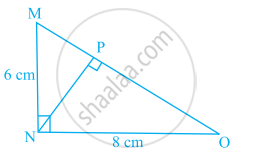Advertisements
Advertisements
प्रश्न
Find the value of k so that the area of the triangle with vertices A (k+1, 1), B(4, -3) and C(7, -k) is 6 square units
उत्तर
`"Let" A(x_1,y_1) = A(k+1,1) , B(x_2,y_2)= B (4,-3) and C(x_3,y_3) = C(7,-k) now`
`"Area "(Δ ABC) = 1/2 [x_1 (y_2-y_3) + x_2 (y_3-y_1) +x_3(y_1-y_2)}`
`⇒ 6=1/2 [(k+1) (-3+k)+4(-k-1) +7(1+3)]`
`⇒6=1/2[k^2 -2k-3-4k-4+28]`
`⇒ k^2-6k+9=0`
`⇒(k-3)^2 = 0⇒k=3`
Hence , k=3
APPEARS IN
संबंधित प्रश्न
Find the area of the quadrilaterals, the coordinates of whose vertices are
(1, 2), (6, 2), (5, 3) and (3, 4)
Four points A (6, 3), B (−3, 5), C(4, −2) and D (x, 3x) are given in such a way that `(ΔDBG) /(ΔABG)=1/2,` find x
Find the centroid of ΔABC whose vertices are A(-1, 0) B(5, -2) and C(8,2)
Find the area of ΔABC with vertices A(0, -1), B(2,1) and C(0, 3). Also, find the area of the triangle formed by joining the midpoints of its sides. Show that the ratio of the areas of two triangles is 4:1.
Find the value(s) of k so that the quadratic equation x2 − 4kx + k = 0 has equal roots.
The table given below contains some measures of the right angled triangle. Find the unknown values.
| Base | Height | Area |
| 20 cm | 40 cm | ? |
The table given below contains some measures of the right angled triangle. Find the unknown values.
| Base | Height | Area |
| ? | 12 m | 24 sq.m |
Points A(3, 1), B(12, –2) and C(0, 2) cannot be the vertices of a triangle.
Find the area of the triangle whose vertices are (–8, 4), (–6, 6) and (–3, 9).
In the given figure, ΔMNO is a right-angled triangle. Its legs are 6 cm and 8 cm long. Length of perpendicular NP on the side MO is ______.

